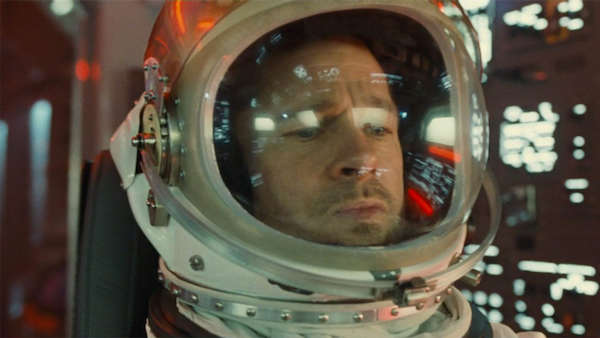Movie review by Greg Carlson
Arthouse sensibilities converge with a major star (having a major year) and elite visual effects in James Gray’s “Ad Astra,” a movie poised to earn the filmmaker his best notices to date in a career spanning 25 years. Set in a near future where space travel to outposts on the moon and Mars functions with the charmless tedium of our contemporary airlines, astronaut Roy McBride (Brad Pitt) is tapped to participate in a curious mission: reach out with a message to his previously presumed-dead dad H. Clifford McBride (Tommy Lee Jones). A legendary pioneer of space exploration and the leader of the extraterrestrial/intelligent life-seeking Lima Project, Clifford is now a prime suspect in a series of mysterious and devastating energy surges.
Roy, whose thoughts we often hear in voiceover, undertakes a harrowing journey of some 2.7 billion miles, experiencing along the way challenges both physical and mental. Gray successfully engages in some creative world-building, and one of the most rewarding aspects of “Ad Astra” is the confident manner in which the filmmaker alternates between Roy’s intimate, introspective headspace and the intensity of turning-point encounters of action. Several of the latter, including an imaginative lunar surface buggy chase and a confrontation with a pair of research animals, worm into the viewer’s brain, unlikely to fade anytime soon.
Regardless of the extent to which one is smitten with the religious allegory and father-son thematic, “Ad Astra” looks absolutely gorgeous. Courtesy of master cinematographer Hoyte van Hoytema’s eye and commitment to creative problem-solving, the movie boasts a lengthy list of stunning visual choices. Primarily originated on motion picture film, “Ad Astra” approaches its otherworldliness via practical and realistic decision-making. In a variety of situations, Van Hoytema deploys everything from slightly higher shooting speeds of 32 to 36 frames per second to a dual rig containing one infrared and one 35mm camera to custom-built, coating-free lenses.
For all the wizardry, however, Gray keeps us close to the turmoil and anxiety experienced by Roy. Pitt, in what might be a career-best performance, could find himself on the Academy’s list of Best Actor nominees for the movies of 2019. The actor does expert work opposite a series of worthy scene partners that includes Donald Sutherland, Ruth Negga, and Jones, but his finest scenes in the film unfold when he isolated and alone. Whether at the controls of a craft, answering psychological evaluation questions, or reflecting with no small amount of regret on personal failures and disappointments, Roy’s calm exterior conceals the emotions men are required by society to keep hidden.
Even though the broad strokes of Gray’s screenplay, co-written with Ethan Gross, suggest a variation on the quest for a rogue, Kurtz-like “emissary of pity, and science, and progress” as imagined in Conrad’s “Heart of Darkness” and Coppola’s “Apocalypse Now,” Gray’s film — like all serious-minded science fiction cinema that blends existential philosophy with feats of technical effects photography — invites comparison to Stanley Kubrick’s “2001: A Space Odyssey.” While the 1968 masterwork remains the gold standard, the evolution of the art form has sparked a renaissance of eye and brain candy. “Ad Astra” joins the likes of “Gravity” and “Interstellar” — photographed, respectively, by Emmanuel Lubezki and van Hoytema — as one of Kubrick’s starchildren.
